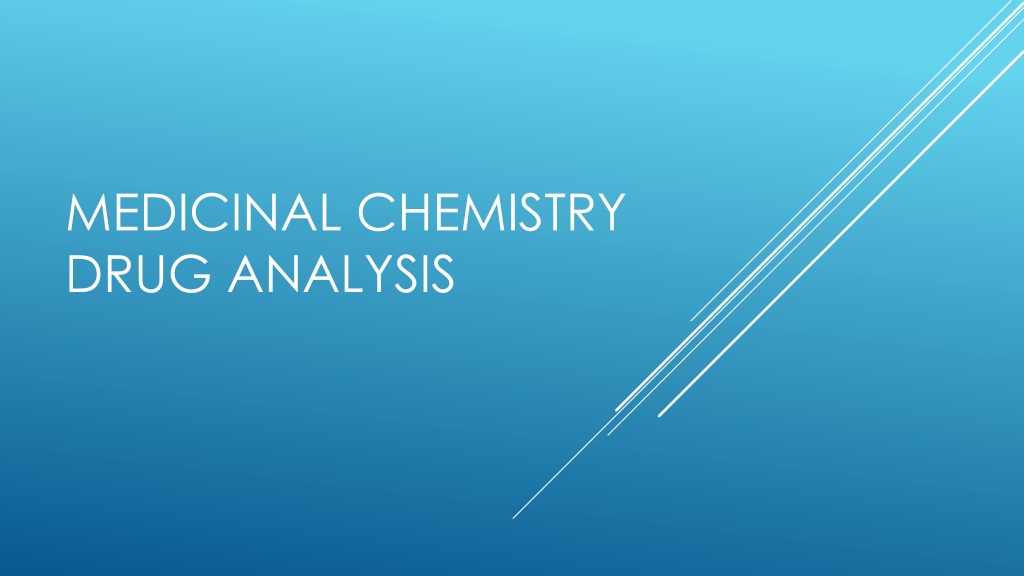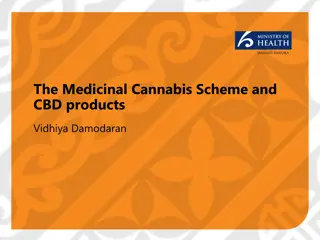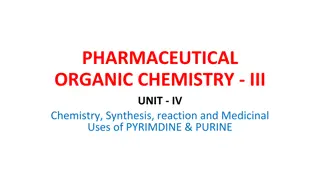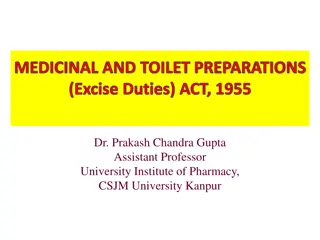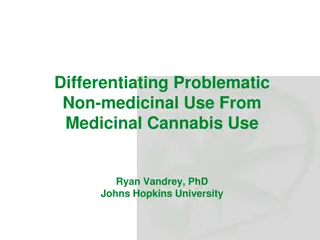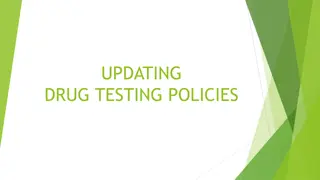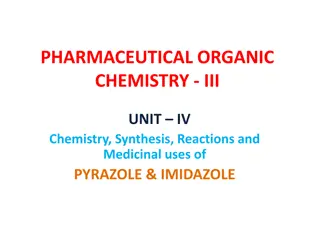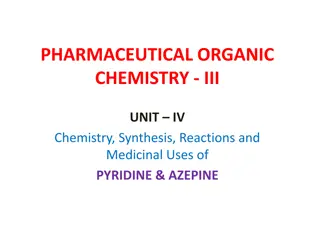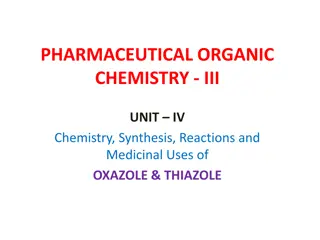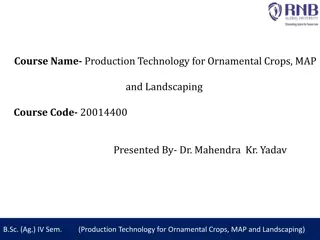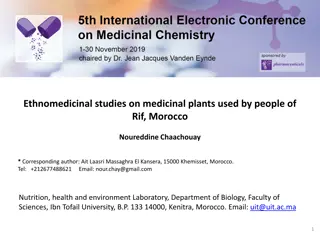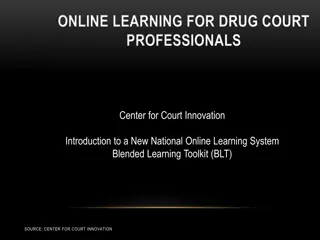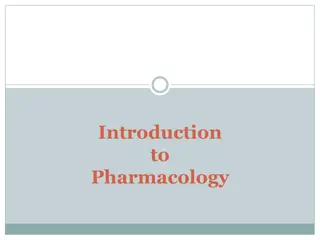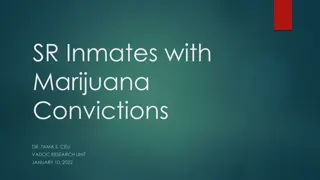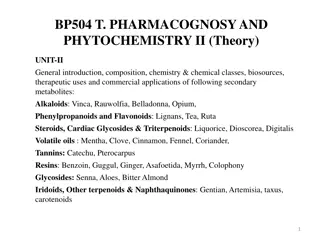Exploring Medicinal Chemistry and Drug Analysis
Medicinal chemistry involves the discovery and development of therapeutic chemicals for medicine, focusing on the interaction of compounds with biological systems. It explores the benefits and drawbacks of drugs, emphasizing the importance of safety and efficacy. Examples such as morphine, barbiturates, and heroin highlight the complex nature of pharmaceutical compounds and their effects on the human body. Additionally, everyday drugs like caffeine and nicotine demonstrate how various substances can elicit biological responses. Medicine strives to balance positive effects with potential risks, aiming for safe and effective treatments.
Download Presentation

Please find below an Image/Link to download the presentation.
The content on the website is provided AS IS for your information and personal use only. It may not be sold, licensed, or shared on other websites without obtaining consent from the author. Download presentation by click this link. If you encounter any issues during the download, it is possible that the publisher has removed the file from their server.
E N D
Presentation Transcript
MEDICINAL CHEMISTRY DRUG ANALYSIS
The science that deals with the discovery or design of new therapeutic chemicals and the development of these chemicals into useful medicine WHAT IS MEDICINAL CHEMISTRY?
Drugs, pharmaceutics Media distinction between drugs that are used in medicine and drugs that are abused (addiction). A compound that interacts with a biological system, and produces a biological response (ideally desired and positive) WHAT IS MEDICINE ?
No medicine has only benefits or drawbacks A good medicine would have to satisfy the following criteria.: it would have to do what it is meant to do and have no toxic or unwanted side effects and be easy to take. Morphine In low dose it is an Excellent analgesic, but have serious side effects such as: Addiction, tolerance (the effect of the drug diminishes after repeated doses and so we need to increase the size of the dose to achieve the GOOD VS. BAD DRUGS same results.) Respiratory depression and it may kill if taken in excess.
Depressants, sedatives, anesthetics General anesthetics in Surgery They are known to cross blood brain barrier because they are fat soluble Overdoses fatal (Pearl Harbor, wounded persons were given these drugs before surgery but many of them died) BARBITURATES ( SERIES OF SYNTHETIC COMPOUNDS WITH SEDATIVE PROPERTIES)
Diamorphine One of the best painkillers ( hero =heroic drug) 1898: on market, but 1903: withdrawn from market due to discovery of its addictive properties. 2006: still used under strict control as the drug of choice for treating patients dying of cancer. It reduces pain as well as it produces a euphoric effect to treat depression in patients close to death HEROIN
Still produce a biological response Caffeine (stimulant), in coffee, tea cocoa(when you take a cup of coffee you are a drug user but when you crave a cup of coffee then you are a drug addict) Sugar reacts with the taste buds of the tongue to produce a sense of sweetness taste Nicotine (sedation or calming effect), in cigarettes EVERYDAY DRUGS
Alcohol is an unsatisfactory drug because it is difficult to judge the correct dose required to gain the happiness effect without drifting into the higher dose levels that produce un wanted side effects such as staggering effect. Also, either happiness or depression may result) Food additives may cause allergies Junk food and fizzy drinks cause hyperactivity in children (contain chemicals that are converted in the body into neurotransmitters leading to excess messages are transmitted in the brain leading to disruptive (unsettling, troublesome) behavior. Vitamins Herbs
Safety of a drug depends on its : Dosage level Almost anything in excess will be toxic but in proper dose it is a good medicine Chronic exposure Measure of safety of drug = therapeutic index. GOOD VS. BAD DRUGS
The therapeutic index (TI; also referred to as therapeutic ratio) is a comparison of the amount of a therapeutic agent that causes the therapeutic effect to the amount that causes toxicity. ... This may be achieved through therapeutic drug monitoring (TDM) protocols. THERAPEUTIC INDEX
Measure of a drugs beneficial effects at low dose vs. harmful effects at high dose Comparison of dose levels which lead to toxic effects to dose levels which lead to maximum therapeutic effects High therapeutic index = large margin of safety Marijuana = 1000 Alcohol = 10 Does not take chronic use into account
A high therapeutic index is good ! The Therapeutic Index of a drug is the ratio of the toxic to the therapeutic dose. Drugs with a low therapeutic index may only require a small increase in dose to produce toxic effects. WHAT DOES IT MEAN TO HAVE A LOW THERAPEUTIC INDEX?
therapeutic index. the ratio between the dosage of a drug that causes a lethal effect and the dosage that causes a therapeutic effect. The ratio between the toxic dose and the therapeutic dose of a drug, used as a measure of the relative safety of the drug for a particular treatment. WHAT DOES THE THERAPEUTIC INDEX MEASURE?
Four main groups (overlap) 1. By biological/pharmacological effect Analgesics, anti-asthmatics, antipsychotics, antihypertensives, antihistaminic, antibiotics ,etc. Large and varied assortment of drugs Many mechanisms of action Some drugs may have more than just one use. CLASSIFICATION OF DRUGS
2. By chemical structure Penicillins, opiates, barbiturates Common skeleton Pharmacological effects may be similar or different uses in medicine
Examples: Antihistamines Affect a certain target system in the body Variety of structures due to large number of stages in system (synthesis, release, receptor interaction and removal of histamine for example) Not all antihistamines are similar compounds By target site of action (more specific) Anticholinesterases (inhibit acetylcholinesterase enzyme in CNS) Target enzyme or receptor with which they interact. Usually common mechanism 3.BY TARGET SYSTEM
